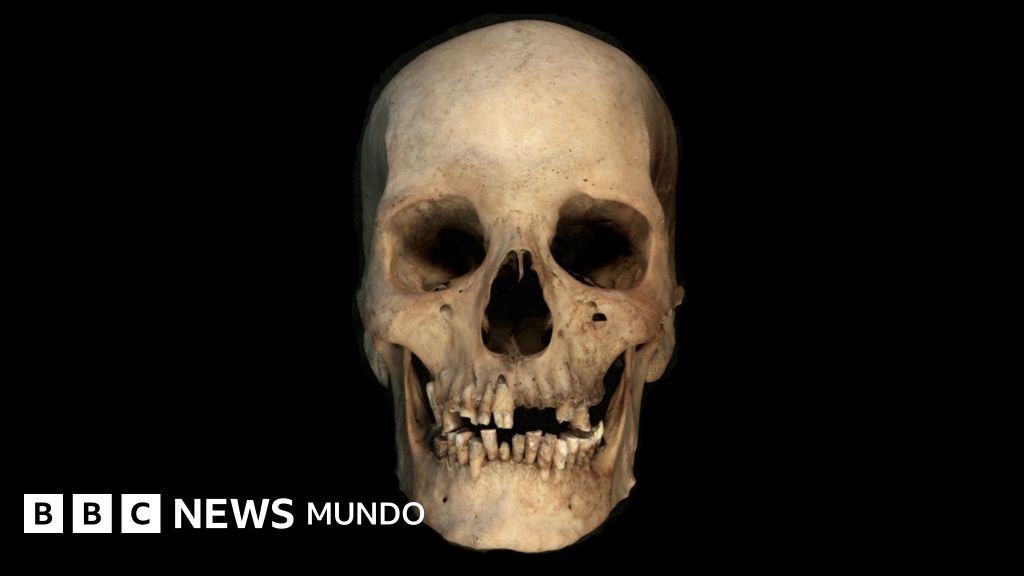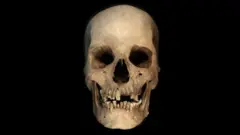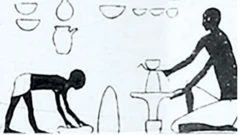

Image source, Liverpool John Moores University. Nature
-
- Author, Pallab ghosh
- Author's title, BBC News Science Corresponsal
- X,
-
A DNA test carried out in the bones of a man who lived 4,500 years ago in the Nile Valley has thrown new light on the boom of the civilization of ancient Egypt.
The analysis of his skeleton reveals that he was 60 years old and that he possibly worked as a potter, but also that a fifth of his DNA came from ancestors living at 1,500 km away, in the other great civilization of the time, in Mesopotamia, the current Iraq.
This is the first biological test of the links between both civilizations and could help explain how Egypt went from being a disparate set of agricultural communities to become one of the most powerful civilizations on Earth.
The findings give a new weight to the theory that writing and agriculture arose thanks to the exchange of people and ideas between these two ancient worlds.

Image source, Liverpool John Moores University/Nature
The main researcher of the study, Professor Pontus Skoglund, of the Francis Crick Institute in London, told BBC News that the ability to extract and read the DNA of ancient bones could shed new light on events and characters of the past, allowing historical events in black and white to come alive with technical details.
“If we get more information about the DNA and compare it with what we know thanks to the archaeological, cultural and written information we have of the time, it will be very exciting,” he said.
Common people
Our understanding of the past is based partly on written records that, often, are stories of the rich and powerful, and mainly also talk about the rich and powerful.
Biological methods are providing historians and scientists with a new tool to see history through the eyes of common people.
The DNA was extracted from an inner ear of the remains of a man buried in Nuwayrat, a town located 265 km south of Cairo.
He died between 4,500 and 4,800 years, a moment of transformation in the emergence of Egypt and Mesopotamia. The archaeological evidence indicates that both regions could have been in contact at least 10,000 years ago, when the inhabitants of Mesopotamia began to cultivate the land and domesticate animals, which led to the emergence of an agricultural society.
Many scholars believe that this social and technological revolution could have influenced similar developments in ancient Egypt, but so far there were no direct contact evidence.

Image source, Garstang Museum/Liverpool University/Nature
Adeline Morez Jacobs, who analyzed the remains as part of his doctorate at the John Moores University of Liverpool, states that it is the first clear test of a significant migration of people and, therefore, of information between the two civilization centers of the time.
“There are two regions that developed the first writing systems, so archaeologists believe they were in contact and exchanged ideas. We now have the proof that it was,” he explained.
“We hope that future DNA samples of ancient Egypt can expand information about when exactly this movement began from Western Asia and what was its reach.”
The man was buried in a ceramic vessel in a tomb excavated on the slope of a hill. His burial took place before artificial mummification was a usual practice, which may have helped preserve his DNA.
When investigating the chemical compounds of his teeth, the research team was able to discern what he ate and, from there, determined that he had probably grown up in Egypt.
But the story of scientific detectives does not end there.

Image source, The Metropolitan Museum of Art
What was the potter like?
Professor Joel Irish, from the John Moores University of Liverpool, carried out a detailed analysis of the skeleton to rebuild the image of this man as an individual.
“What I wanted was to find out who this man was, to know everything possible about him, to know what age he was, what his height was, what he did, and try to humanize the whole matter instead of treating him as a cold specimen,” he said.
The bone structure indicated that the man was between 45 and 65, although the signs of arthritis that had inclined the calculation towards the older age. It measured just over 1.57 m, which was even considered low.
Professor Iish could also determine what he was probably a potter. The hook -shaped bone from the back of his skull was enlarged, which indicated that he looked a lot down.
His ischions were enlarged, which suggests that he sat on hard surfaces for prolonged periods. His arms showed signs of intense movements forward and backward, and there were marks in them where the muscles had grown, indicating that he was accustomed to lifting heavy objects.
“This shows that he worked tirelessly. He worked all his life,” the American academic told the BBC.
Dr. Linus Gredland Flink explained that only thanks to a tremendous stroke of luck, this skeleton could be studied and reveal its historical secrets.
“He was unearthed in 1902 and donated to the World Museum in Liverpool, where he survived the bombings of World War II that destroyed most of the human remains of his collection,” he said.
“Now we have been able to tell part of the history of this individual, discovering that some of their ancestors came from the growing fertile, which highlights the mixture between groups at this time,” he said.
New research has been published in the magazine Nature.








